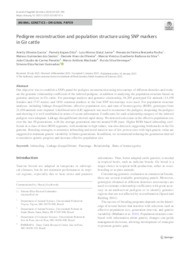Pedigree reconstruction and population structure using SNP markers in Gir cattle.
Pedigree reconstruction and population structure using SNP markers in Gir cattle.
Autoria: GARCIA, A. O.; OTTO, P. I.; GLATZL JUNIOR, L. A.; ROCHA, R. de F. B.; SANTOS, M. G. dos; OLIVEIRA, D. A. de; SILVA, M. V. G. B.; PANETTO, J. C. do C.; MACHADO, M. A.; VERNEQUE, R. da S.; GUIMARÃES, S. E. F.
Resumo: Our objective was to establish a SNPs panel for pedigree reconstruction using microarrays of different densities and evaluate the genomic relationship coefficient of the inferred pedigree, in addition to analyzing the population structure based on genomic analyses in Gir cattle. For parentage analysis and genomic relationship, 16,205 genotyped Gir animals (14,458 females and 1747 males) and 1810 common markers to the four SNP microarrays were used. For population structure analyses, including linkage disequilibrium, effective population size, and runs of homozygosity (ROH), genotypes from 21,656 animals were imputed. Likelihood ratio (LR) approach was used to reconstruct the pedigree, deepening the pedigree and showing it is well established in terms of recent information. Coefficients for each relationship category of the inferred pedigree were adequate. Linkage disequilibrium showed rapid decay. We detected a decrease in the effective population size over the last 50 generations, with the average generation interval around 9.08 years. Higher ROH-based inbreeding coefficient in a class of short ROH segments, with moderate to high values, was also detected, suggesting bottlenecks in the Gir genome. Breeding strategies to minimize inbreeding and avoid massive use of few proven sires with high genetic value are suggested to maintain genetic variability in future generations. In addition, we recommend reducing the generation interval to maximize genetic progress and increase effective population size.
Ano de publicação: 2023
Tipo de publicação: Artigo de periódico
Unidade: Embrapa Gado de Leite
Palavras-chave: Bovino, DNA, Endogamia, Gado Gir, Marcador Genético
Observações
1 - Por padrão são exibidas publicações dos últimos 20 anos. Para encontrar publicações mais antigas, configure o filtro ano de publicação, colocando o ano a partir do qual você deseja encontrar publicações. O filtro está na coluna da esquerda na busca acima.
2 - Para ler algumas publicações da Embrapa (apenas as que estão em formato ePub), é necessário ter, no celular ou computador, um desses softwares gratuitos. Sistemas Android: Google Play Livros; IOS: iBooks; Windows e Linux: software Calibre.
Acesse outras publicações
Acesse a Base de Dados da Pesquisa Agropecuária (BDPA) para consultar o acervo completo das bibliotecas da Embrapa.

